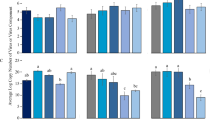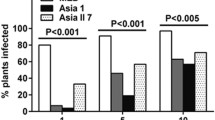Abstract
Zoospores of 12 isolatesO. bornovanus from geographically diverse sites and representing the three host specific cucurbit strains were tested as vectors for seven viruses using watermelon bait plants and the in vitro acquisition method. All isolates of the cucumber, melon, and squash strains transmitted melon necrotic spot carmovirus (MNSV) and cucumber necrosis tombusvirus (CNV) but none transmitted petunia asteroid mosaic tombusvirus (PAMV) or tobacco necrosis necrovirus (TNV). The isolates varied as vectors of three other carmoviruses: cucumber leaf spot virus (CLSV); cucumber soil borne virus (CSBV); and squash necrosis virus (SqNV). All cucumber isolates transmitted CLSV and SqNV but not CSBV. Some of the melon isolates transmitted CLSV and SqNV but none transmitted CSBV. Two squash isolates transmitted CSBV and SqNV but not CLSV. Two isolates ofO. brassicae transmitted only TNV and a third did not transmit any of the viruses. The species of bait plant sometimes affected transmission. The most efficient vector strains ofO. bornovanus, as determined by reducing zoospores and virus in the inoculum, were the cucumber strain for CLSV; the cucumber strain for CNV if cucumber was the bait plant or melon strain if watermelon was the bait plant; and the squash strain for SqNV. The plurivorous strain ofO. brassicae was the most efficient vector of TNV.Olpidium bornovanus is the first vector reported for CSBV and is confirmed as a vector of SqNV. It is proposed that all carmoviruses may have fungal vectors.Ligniera sp. did not transmit any of the viruses in one attempt.
Similar content being viewed by others
Abbreviations
- CLSV:
-
cucumber leaf spot virus
- CNV:
-
cucumber necrosis virus
- CSBV:
-
cucumber soil borne virus
- MNSV:
-
melon necrotic spot virus
- PAMV:
-
petunia asteroid mosaic virus
- SqNV:
-
squash necrosis virus
- TNV:
-
tobacco necrosis virus
- TBSV:
-
tomato bushy stunt virus
References
Barr DJS (1968) A new species ofOlpidium parasitic on cucumber roots. Canadian Journal of Botany 46: 1087–1091
Bowen R and Plumb RT (1979) The occurrence and effects of red clover necrotic mosaic virus in red clover (Trifolium pratense). Annals of Applied Biology 91: 227–236
Campbell RN (1968) Transmission of tomato bushy stunt virus unsuccessful withOlpidium. Plant Disease Reporter 52: 379–380
Campbell RN (1979) Fungal vectors of plant viruses, pp 8–24 in Molitoris HP, Hollings M and Wood HA (eds) Fungal Viruses, XIIth Int. Congr. Microbiology, Mycology Section, Munich, 3–8 September, 1978, Springer-Verlag, Berlin
Campbell RN (1988) Cultural characteristics and manipulative methods, pp 153–165 in Cooper JI and Asher MJC (eds) Viruses with Fungal Vectors, Assn Appl Biol, Wellesbourne, UK
Campbell RN, Lecoq H, Wipf-Scheibel C and Sim ST (1990) Soil-borne viruses of melons and cucumbers in France, pp 153–154 in Koenig R (ed) Proc. 1st Symp Int Work Group on Plant Viruses with Fungal Vectors, Braunschweig, August 21–24, 1990, Vol 1, Ulmer GmbH, Stuttgart, Stuttgart
Campbell RN, Lecoq H, Wipf-Scheibel C and Sim ST (1991) Transmission of cucumber leaf spot virus byOlpidium radicale. Journal of General Virology 72: 3115–3119
Campbell RN, Lovisolo O and Lisa V (1975) Soil transmission of petunia asteroid mosaic strain of tomato bush stunt virus. Phytopathologia Mediterranea 14: 82–86
Campbell RN and Sim ST (1994) Host specificity and nomenclature ofOlpidium bornovanus (=Olpidium radicale) and comparisons toOlpidium brassicae. Canadian Journal of Botany 72: 1136–1143
Dias HF (1970a) The relationship between cucumber necrosis virus and its vector,Olpidium cucurbitacearum. Virology 42: 204–211
Dias HF (1970b) Transmission of cucumber necrosis virus byOlpidium cucurbitacearum Barr and Dias. Virology 40: 828–839
Furuki I (1981) Epidemiological studies on melon necrotic spot. Tech Bull 14 94 pp. Shizuoka Agr Exp Sta, Shizuokaken, Japan
Gerhardson B and Insunza V (1979) Soil transmission of red clover necrotic mosaic virus. Phytopathologische Zeitschrift 94: 67–71
Kassanis B and MacFarlane I (1965) Interaction of virus strain, fungus isolate, and host species in transmission of tobacco necrosis virus. Virology 26: 603–612
Koenig R, Lesemann D-E, Huth W and Makkouk KM (1983) comparison of a new soilborne virus from cucumber with Tombus-, Diantho-, and other similar viruses. Phytopathology 73: 515–520
Lange L and Insunza V (1977) Root-inhabitingOlpidium species: theO. radicale complex. Transactions British Mycological Society 69: 377–384
Lin MT, Campbell RN, Smith PR and Temmink JHM (1970) Lettuce big-vein virus transmission by single-sporangium isolates ofOlpidium brassicae. Phytopathology 60: 1630–1634
Lin MT, Kitajima EW and Munoz JO (1983) Isolation and properties of squash necrosis virus, a possible member of ‘tobacco necrosis virus’ group. Fitopatologia Brasileira 8: 622
Lin MT and Palagi PM (1983) First report of the fungus, cucurbit strain ofOlpidium radicale, in Brazil and its association with squash necrosis virus. Fitopatologia Brasileira 8: 622
Martelli GP, Gallitelli D and Russo M (1988) Tombusviruses, pp 13–72 in Koenig R (ed) The Plant Viruses, Vol 3, Plenum Press, New York
McKeen CD (1959) Cucumber necrosis virus. Canadian Journal of Botany 37: 913–925
Morris tJ and Carrington JC (1988) Carnation mottle virus and viruses with similar properties, pp 73–112 in Koenig R (ed) The Plant Viruses, Vol 3, Plenum Press, New York
Rochon D and Tremaine JH (1988) Cucumber necrosis virus is a member of the tombusvirus group. Journal of General Virology 69: 395–400
Sahtiyanci S (1962) Studien über einige wurzelparasitare Olpidiaceen. Archiv für Mikrobiologie 41: 187–228
Teakle DS and Gold AH (1963) Further studies ofOlpidium as a vector of tobacco necrosis virus. Virology 19: 310–315
Temmink JHM, Campbell RN and Smith PR (1970) Specificity and site of in vitro acquisition of tobacco necrosis virus by zoospores ofOlpidium brassicae. Journal of General Virology 9: 201–213
Weber I, Stanarius A and Kalinina I (1986) Further investigations on the serological relation between cucumber leaf spot virus and cucumber fruit streak virus. Archiv für Phytopathologie und Pflanzenschutz 22: 169–170
Author information
Authors and Affiliations
Rights and permissions
About this article
Cite this article
Campbell, R.N., Sim, S.T. & Lecoq, H. Virus transmission by host-specific strains ofOlpidium bornovanus andOlpidium brassicae . Eur J Plant Pathol 101, 273–282 (1995). https://doi.org/10.1007/BF01874783
Accepted:
Issue Date:
DOI: https://doi.org/10.1007/BF01874783




